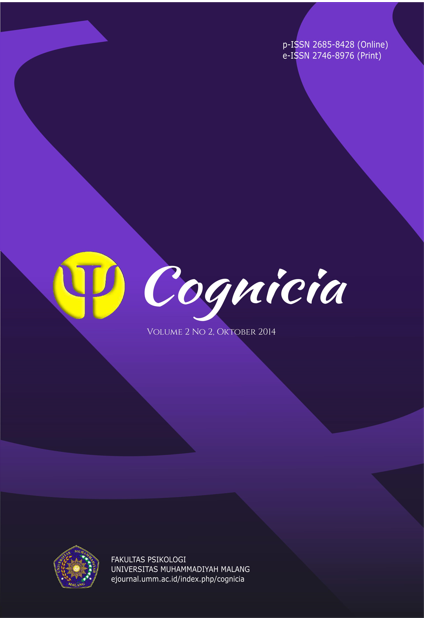ORIENTASI KELEKATAN DAN REAKSI DUKA CITA AKIBAT KEMATIAN HEWAN PELIHARAAN
DOI:
https://doi.org/10.22219/cognicia.v2i2.2011Abstract
Memelihara hewan merupakan aktivitas umum yang dilakukan oleh manusia. Peningkatan jumlah kepemilikan hewan peliharaan berdampak pada peningkatan jumlah pemilik hewan peliharaan yang mengalami kehilangan hewan peliharaan akibat kematian. Kematian hewan peliharaan keberadaannya dinilai dapat memenuhi fungsi dasar kelekatandan berperan sebagai figur kelekatan akan menimbulkan reaksi duka cita bagi pemiliknya. Penelitian ini menguji pengaruh orientasi kelekatan cemasdan orientasi kelekatan menghindarterhadap reaksi duka cita akibat kematian hewan peliharaan. Subjek penelitian yang hewan peliharaannya mati dalam 2 tahun terakhir (N = 159) mengisi skala Pet Attachment Questionnaire dan Core Bereavement Items. Orientasi kelekatan cemasdan orientasi kelekatan menghindarmemiliki pengaruh signifikan terhadap reaksi duka cita akibat kematian hewan peliharaan (F = 22,234, p < 0,001), akan tetapi kontribusi yang diberikan kecil (adj. R2 = 0,213). Sebesar 21,3% variasi reaksi duka cita dipengaruhi oleh orientasi kelekatan cemasdan orientasi kelekatan menghindar.Orientasi kelekatan cemas berpengaruh lebih besar pada reaksi duka cita akibat kematian hewan peliharaan.
Kata kunci: Orientasi kelekatan cemas, orientasi kelekatan menghindar, reaksi duka cita
Raising animals is part of daily activities. More and more people own a pet. And as the pets died, the owner might feel remorse and grief. The death of a pet is considered to meet the basic functions of attachment as the pet served as an attachment figure.This research examined the impact of pet anxiety attachment and pet avoidant attachment toward grief over the loss of a pet. Participants whose companion animal died within past 2 years (N = 159) completed the Pet Attachment Questionnaire and Core Bereavement Items. Both pet anxiety attachment and pet avoidant attachment were found to impacted subjectss’ grief. The result’s contribution was statistically significant (F = 22,234, p < 0,001) but relatively low (adj. R2 = 0,213). Results indicated that 21,3% of the variance in grief can be accounted for the linear combination of pet anxiety attachment and pet avoidant attachment. Furthermore, the pet anxiety attachment’s contribution toward grief were higher.
Keywords : Pet anxiety attachment, pet avoidant attachment, grief
Downloads
Downloads
Published
How to Cite
Issue
Section
License
Copyright (c) 1970 Risa Nur Fitriyana

This work is licensed under a Creative Commons Attribution-ShareAlike 4.0 International License.
Authors who publish with Jurnal Cognicia agree to the following terms:
- For all articles published in Jurnal Cognicia, copyright is retained by the authors. Authors give permission to the publisher to announce the work with conditions. When the manuscript is accepted for publication, the authors agree to automatic transfer of the publishing right to the publisher.
- Authors retain copyright and grant the journal right of first publication with the work simultaneously licensed under a Creative Commons Attribution-ShareAlike 4.0 International License that allows others to share the work with an acknowledgment of the work's authorship and initial publication in this journal.
- Authors are able to enter into separate, additional contractual arrangements for the non-exclusive distribution of the journal's published version of the work (e.g., post it to an institutional repository or publish it in a book), with an acknowledgment of its initial publication in this journal.
- Authors are permitted and encouraged to post their work online (e.g., in institutional repositories or on their website) prior to and during the submission process, as it can lead to productive exchanges, as well as earlier and greater citation of published wor (See The Effect of Open Access).

This work is licensed under a Creative Commons Attribution-ShareAlike 4.0 International License







